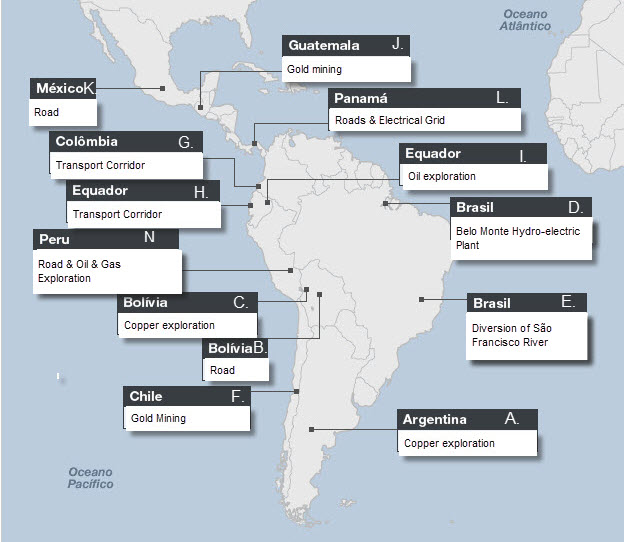At a time when the world talks about Latin America’s economic boom, with predictions of growth and poverty reduction, there are people who are not only not benefiting from such prosperity but have become its victims. The current huge investments in highways, power stations and river ways to facilitate the export of minerals, oil and agricultural products threaten the very existence of indigenous communities, for whom the land is not only a source of food but also a sacred element of their culture. From Mexico to Argentina, from Guatemala to Peru, indigenous communities are fighting back against the mines, roads and wells that are destroying their lands. This map shows a comprehensive range of projects that threaten the indigenous communities in Latin America.
 Source: Instituto Humanista Unisinos
Source: Instituto Humanista Unisinos
A. Argentina
Where: Neuquén
What: Copper mining.
The Mapuche Indians of the communities of Mellao Morales and Huenctru Trawel Leufu have been attempting since 2008 to get a contract for copper mining within their reserves cancelled. They say that the mining violates indigenous and environmental laws. A judicial ruling has suspended mining until the Indians have been consulted.
B. Bolivia
Where: Tipnis
What: Highway construction
Indigenous peoples say that the highway, which will be financed by the Brazilian development bank, BNDES, and built by a Brazilian company, will affect the communities in Tipnis Park. Protests held last year brought construction to a standstill. The government claims that it will consult the Indians before resuming the project.
C. Where: Pacajes, La Paz
What: Copper exploitation
Indigenous peoples claim that mining in the reserve of Jach’the Suyu Pakajaqui, at a cost of US$200 million, was started without environmental license; it also led to the rerouting and pollution of a river. The community has appealed to the Inter-American Commission on Human Rights to halt the project.
D. Brazil
Where: Altamira (State of Pará).
What: Belo Monte hydroelectric power station
Indigenous peoples from 28 ethnic groups, who live in the Xingu River Basin, say that the work will reduce the flow of the river, affecting the fish, and will attract immigrants to the region. They also say they were not consulted on the project and are trying to get the courts to stop it.
E. Where: North of Minas Gerais and other states.
What: Diversion of São Francisco River.
Indigenous movements say that at least 18 communities, some of whom have not had their territories recognised by the state, may be affected by work undertaken to divert the river. They also claim that they have not been consulted. One group has brought a complaint to the United Nations about the disastrous consequences of the work.
F. Chile
Where: Border with Argentina
What: Gold mining
The Los Huascoaltinos indigenous community is opposed to the open mining project of Pascua Lama, which began ten years ago. They say that the mining has caused environmental damage and have made a formal complaint against the Chilean State which has now been admitted by the Inter-American Commission on Human Rights.
G. Colombia
Where: Tumaco (Nariño) – Puerto Assis (Putumayo).
What: Transport Corridor
Indigenous peoples say that this billion-dollar project, which is in the research and development stage and will connect Tumaco in the Pacific to Belém in Brazil, will cross old indigenous territories. Prior consultation with the affected communities, as determined by Convention 169 of the International Labour Organization (ILO), was not carried out, they say.
H. Ecuador
Where: Manta (Manabí)
What: Transport Corridor
This work to link the Ecuadorian city of Manta on the Pacific with Manaus in Brazil includes roads, airports and river connections. Indigenous peoples claim that the project will affect territories along the Napo River and say that they have not been consulted.
I. Where: Yasuní National Park (Pastaza, Orellana).
What: Oil exploration
Called ‘Project ITT’, it threatens previously un-contacted tribes in Ecuador, according to local indigenous organizations. They are demanding that the government guarantees that, in accordance with UN guidelines for isolated peoples, indigenous territories will not be affected.
J. Guatemala
Where: San Juan Ostuncalco, Cabricán e Huitán (Quetzaltenango)
What: Gold mining
Indigenous peoples are trying to stop the gold mining, which began in 2005. They say that the rivers have been contaminated and that the money it produces does not benefit the local population.
K. Mexico
Where: Bolaños-Huejuquilla (Jalisco)
What: Highway construction
The Huicholes Indigenous Community (Wixarika) has been struggling since 2005 against the construction of the highway, which will link Bolaños and Huejuquilla. They say that the construction works are leading to the eviction of indigenous communities, destroying sacred sites and affecting water sources.
L. Panama
Where: Panama
What: Highway and energy integration
Designed to integrate Central America into Colombia in the south and Mexico in the north, the Puebla-Panama Plan (renamed the Mesoamerica Project) will lead to huge investment in highways and electrical plants. Indigenous peoples in the region demand to be consulted on the plan and fear its consequences.
M. Peru
Where: Madre de Dios
What: Road and oil and gas exploration
Indigenous movements say that the Inter-Oceanic Highway, connecting Peru to Brazil, has encouraged the migration into the Peruvian Amazon of mining companies, which are invading indigenous territories, polluting rivers and hunting illegally. They are calling on the government to restrict the activity of these groups and to stop them prospecting for oil and gas in the region.
Instituto Humanista Unisinos

